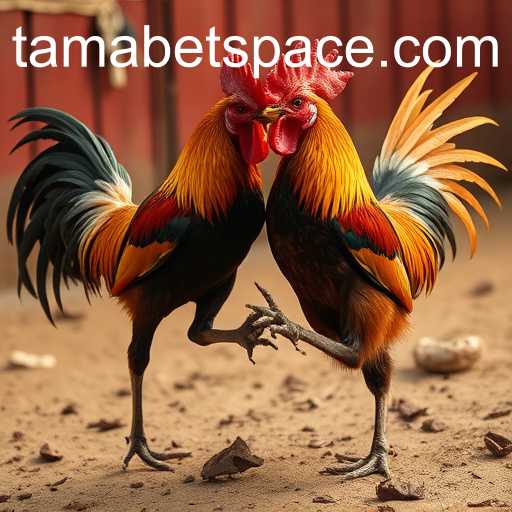
Why Choose Sport in tamabet space
- ⚽
Full Coverage
Follow a wide variety of sports, including football, basketball, and more.
- 📊
Detailed Statistics
Access comprehensive data to help you make informed decisions.
- 🎁
Special Promotions
Earn exclusive bonuses and participate in end-of-year offers.
The Complex World of Cockfighting and Tamabet Space
- 🏆
Soccer
Watch live matches and enjoy the best betting options.
- 🏀
Basketball
Dive into the on-court action with exclusive stats and analysis.
- 🎾
Tennis
Bet on international tournaments with competitive odds.
The Digital Evolution of Online Lottery
Explore the burgeoning world of online lottery, focusing on the role of tamabet space and the broader digital transformation of traditional lotteries in the modern world.
- 📖
Study team statistics and performance before betting.
- 🕒
Gamble responsibly and set clear limits.
- 💡
Take advantage of seasonal promotions to maximize your earnings.

Cockfighting

Cockfighting and Its Cultural Implications: An In-Depth Look at the Tamabet Space
Introduction to Cockfighting
Cockfighting is a controversial and ancient blood sport that has spanned cultures across the globe. Rooted deeply in the traditions of many societies, it involves two roosters, specifically bred for aggression, battling it out in a pit for entertainment purposes. The significance of cockfighting extends beyond mere entertainment as it intersects with communal identity, economic factors, and cultural traditions. With its rich history, cockfighting still exists in many parts of the world, despite being banned in numerous countries due to animal cruelty concerns.
The Cultural Significance of Cockfighting
Cockfighting holds differing meanings and importance depending on geographic location and cultural interpretation. In places like Southeast Asia, Latin America, and some parts of Europe, cockfighting is not just a pastime but a vibrant reflection of local traditions and social interactions. It is often intertwined with local festivals and ceremonial occasions, forming a communal bond among those who participate as spectators and bettors.
The cultural depth of cockfighting is evident in the intricacies involved in raising and training the birds. Roosters are meticulously cared for and trained, often reflecting the socioeconomic status of their owners. Winning in tournaments is not just about monetary gains but also about honor and prestige within the community.
The Economics Behind the Tamabet Space
Beyond the cultural fabric, cockfighting holds significant economic implications. "Tamabet space" refers to the financial ecosystem surrounding this activity. Despite legal restrictions in many countries, tamabet space continues to flourish clandestinely. It involves a network of breeders, trainers, and bettors who are deeply invested in the outcomes of cockfights.
The betting associated with tamabet space is often informal, yet it can escalate into a competitive and lucrative venture. Some arenas operate legally under regulatory oversight, often serving as tourist attractions where legal caveats permit the sport to persist under specific conditions. In such scenarios, tamabet space transforms into a tightly regulated industry, with revenues contributing to local economies and tourism.
Controversies and Legal Challenges
The ethical and legal challenges enveloping cockfighting cannot be overlooked. Animal rights activists vehemently oppose the sport, citing the inherent cruelty involved in pitting animals against each other for human benefit. The use of spurs and other augmentative tools to increase the fight's intensity often results in severe injuries or death for the animals involved.
Countries around the world have responded with varying degrees of severity. In the United States, cockfighting is illegal in all states, with federal laws imposing strict penalties on those who participate in or facilitate such events. In contrast, places such as Puerto Rico have a deeply ingrained tradition of cockfighting, where local laws have, until recently, created a legal space for its practice.
Modern Adaptations and Future Prospects
The future of cockfighting is as contentious as its history. In some regions, modern adaptations seek to preserve cultural heritage while addressing ethical concerns. For instance, some communities have explored virtual cockfighting—where the cultural significance and excitement remain intact without the direct physical harm to animals.
In an increasingly globalized world, the question remains whether the cultural elements of cockfighting can be disentangled from the ethical issues it presents. The evolving legal landscape coupled with advancements in animal rights protections continue to shape how cockfighting may evolve within or outside the tamabet space.
Conclusion
Cockfighting, deeply entrenched in cultural heritage and economics, finds itself at a crossroads of tradition and modern ethical scrutiny. While some advocate for its cultural preservation in controlled environments, others call for stricter regulations or outright bans, stemming from a broader global conversation about animal rights and welfare. The tamabet space reflects an intricate dance between maintaining cultural identity and adapting to contemporary moral standards.
Breaking News
-

Dive into the adventurous world of AllStarTeam, exploring Tamabet Space, where players strategize to build the ultimate team in an intergalactic setting.
-

Discover the enchanting universe of MagicScroll, a thrilling game set in the mystical Tamabet Space.
-

Discover ReelAllStars, the captivating game set in the intriguing universe of Tamabet Space. Learn about its unique features, gameplay, and rules.
-

Explore the enchanting realm of ElementalLinkWater, a game that combines strategy, adventure, and magic within the mysterious Tamabet Space. Immerse yourself in its unique gameplay and current relevance.
-

Explore the captivating world of PenaltyShootOut, a game revolutionizing virtual sports under the innovative Tamabet space, blending immersive play with real-time excitement.
-

Explore the innovative gameplay mechanics and exciting rules of FruityWheel, the latest sensation in the digital game domain that blends fruit-themed challenges with the expansive Tamabet space.
-

Discover the exciting world of BanditBustBonusBuy, a captivating game set in the intriguing Tamabet Space, where players can immerse themselves in strategic gameplay and thrilling adventures.


